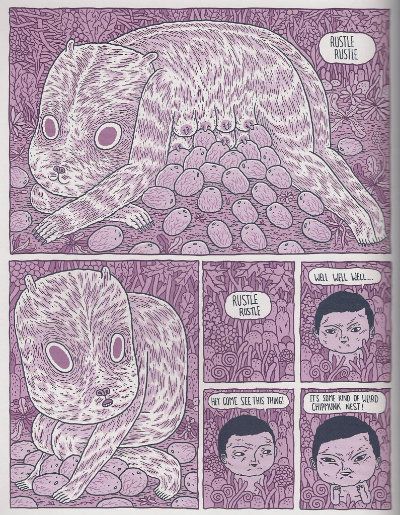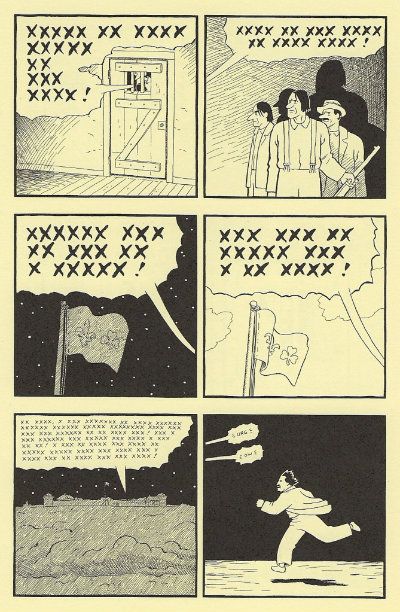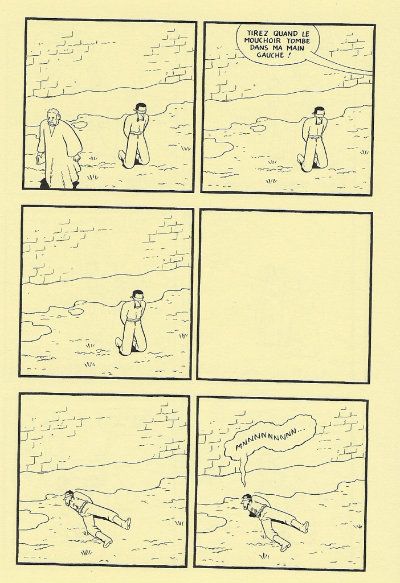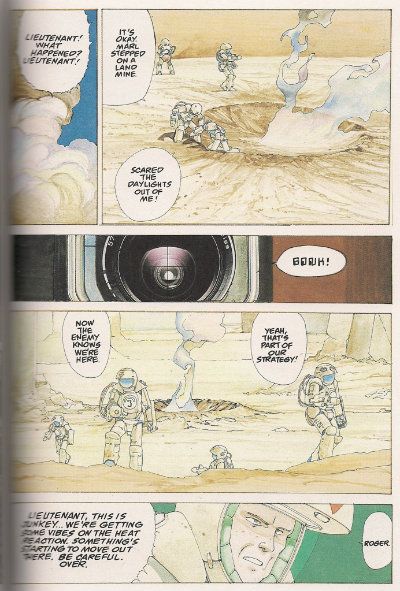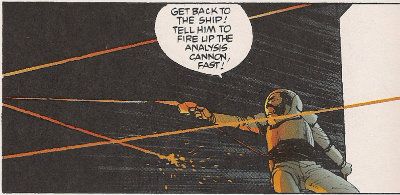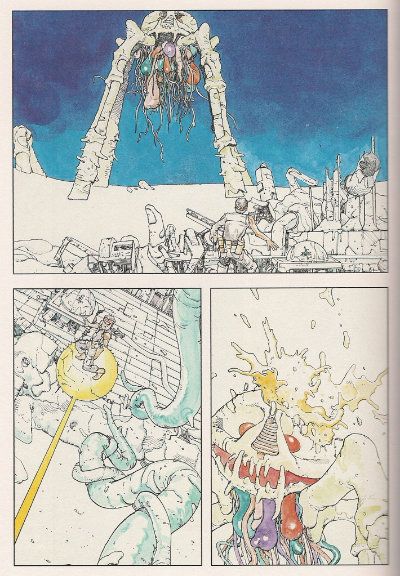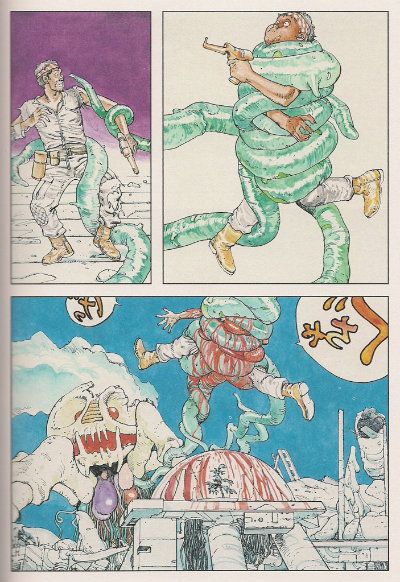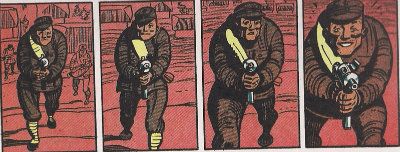CBABIH 0.7 - Show Notes
Being a belated and somewhat smaller-than-usual series of comments -- owing to my present tenancy at the historic Overlook Hotel -- on Episode 0.7 of Comic Books Are Burning In Hell, a podcast by Matt Seneca, Tucker Stone, Chris Mautner and myself.
00:00: A hearty "welcome back" to our beloved Satan running joke, and [ASSIDUOUSLY NEUTRAL NATIONAL FEDERATION OF INDEPENDENT BUSINESS v. SEBELIUS JOKE]! I hereby pledge not to allow my present circumstances to detract whatsoever from the quality of these notes!
00:14: This particular session was recorded on Sunday, June 24, with the crew again divided into teams of two, again split between a basement in Elizabethtown, PA, and a dangerous sweat box in Brooklyn, NY. Seriously, Tucker and Matt forgo even the distraction of air conditioning to better focus on top-notch comic book discussion content, much like the ascetics of old breaking down the Battle of Hastings action choreography on the Bayeux tapestry while podcasting into thin air (which is basically what Chris and I do anyway - no mics for these E-Town cats).
01:16: Onward Towards Our Noble Deaths and NonNonBa, by Shigeru Mizuki. Both published in English by Drawn and Quarterly, the former well over a year ago, hence my joke about everyone getting there before me. I get into the differing stories/narrative stances of each in the show, so I won't summarize them here.
01:33: The Bart Beaty review to which I refer is here. It actually took him eight days to choke down the book. Critical passage:
"Ultimately the problem here is that the book is simply its concept: an autobiographical work combining an element of the fantastic, a book that says 'hey, youth is a magical time of imagination'. Thanks, got it. NonNonBa really exists on a very shallow level where nothing further is made of that simplistic observation. Once you get past the obvious moral of the story, you realize that this big book is really paper thin."
This is the crux of my disagreement with Beaty; with all due respect, I think it's his reading that's shallow, insofar as he misidentifies the work's engine as a 'magic' inherent to childhood rather than a learned means of processing the often-mortal peril of same.
That said, I'm probably misstating Beaty's relative unfamiliarity with manga, in that he does specifically cite two other Japanese comics from the '07 Angoulême competition as superior: Kazuichi Hanawa's Doing Time (released in English by Fanfare/Ponent Mon) and Hideki Arai's Ki-itchi!! (not officially in English, although I recall his violent '90s seinen series The World is Mine becoming a minor thing on the scanlation circuit a few years back). I'd actually agree on the superiority of Doing Time, a dryly obsessive chronicle of three years the artist spent in prison on weapons possession charges.
(Also, the specific prize NonNonBa won was the Fauve d'Or, awarded to the year's best album.)
03:28: Beaty's review of Christophe Blain's Gus and His Gang is here (not as harsh as my crap memory made it out to be); I've linked to Matthias Wivel's opening salvo before, but here it is again.
04:06: I should have said I mostly know of Thomas Thorhauge's English-language criticism via the Metabunker, where he recently authored a scathing take on Kramers Ergot 8. Xavier Guilbert springs to mind through his work at du9. Bart Croonenborghs has done a lot of online work for The Comics Journal, although he mainly writes online now at Broken Frontier. Had I known Chris was going to bring up comments sections -- and were I equipped to react to things without prompting akin to the laserdisc playback on an arcade gunfighting game coming to full pause on 'easy' mode -- I'd have thrown out some mention of "Tony" from my own column at the Journal, who just recently dusted off an April thing I did on mangaka Kazumasa Takayama (of quintessential Studio Proteus/Dark Horse obscurity Chronowar) with some great new info.
I also beg the forgiveness of Pedro Bouça for getting his familial name completely wrong. UGH.
05:16: It's always worthwhile to return to the source texts, such as François Truffaut's A Certain Tendency of the French Cinema, known as the traditional birthplace of auteur theory, but also significantly a political reaction to the anti-clericalism Truffaut noted in the so-called Tradition of Quality.
06:36: Full title - Unpopular Culture: Transforming the European Comic Book in the 1990s. From the University of Toronto Press.
10:31: Onwards Toward Our Noble Deaths was 1973; NonNonBa was 1977. If you want to compare & contrast the art styles involved, sample images are here and here.
11:00: The Drawn and Quarterly release of GeGeGe no Kitarō (serialized 1959-69) will simply be titled Kitaro, once again revealing the New Age musical tastes of our neighbors to the north. I'm really glad the Mizuki books have done well for them.
13:56: For more on the history of kamishibai -- which I appear to have confused with kamibashi string dolls, not that I even pronounced that right -- I'll recommend Abrams' profusely illustrated 2009 release of Manga Kamishibai: The Art of Japanese Paper Theater, by Eric P. Nash. "The Lone Wolf and Cub guy" Tucker mentions is artist Goseki Kojima, whom we might also call an accidental godfather of the '80s superhero upheavals, owing to his influence on Frank Miller.
18:37: Not only did Mizuki indeed employ art assistants, one of them was none other than art manga legend Yoshiharu Tsuge, whose own visual approach in works like Screw-Style was directly influenced by Mizuki's example.
20:57: In Scott McCloud's limited defense, I've always read Understanding Comics as less an attempt at a definitive statement on the makeup the form than a necessary effort at collating various theories and suppositions into book form, perhaps as a means of bypassing the usual turnover in comics crit/theory - while comic book readers don't always flip themselves to some other area of interest to make way for the next reading generation every five years, as went the received wisdom, comics critics often do, forcing each new crew of obsessives to study up on the past and learn the same damn lessons over and over. That Understanding Comics is even still widely read is a major victory in that regard.
22:06: Tucker wrote a bit more about Onwards Toward Our Noble Deaths here. For a more abashed take, I'll recommend Sean T. Collins' review, which raises an interesting potential problem with the book: that Mizuki's emphasis on the humanity-as-lived of his soldier cast renders the whole ethos of the honorable death somewhat inexplicable, and seemingly the province of a diseased few, a perspective that does not hold up to history. In response, I'd note that Mizuki's primary audience, however, was a Japanese readership a little over one quarter of a century removed from the events depicted, which would benefit more, perhaps, from a display of shared burden than any explication of an attitude most readers would be familiar with anyway - in this way, depicting the attitude as aberrational might be a deliberate artistic (or even political) goal, though query, of course, whether this doesn't stand as an elaborate excuse for the very real, prolific atrocities committed by the Japanese imperial machine in the time period.
29:34: Matt's mention of Kōbō Abe suggests the writer's (also 1973!) novel The Box Man, which brings to mind artist Imiri Sakabashira, who did a surreal manga also titled The Box Man, which Drawn and Quarterly released to booming silence in 2010. Like when a mangaka throws in a gigantic sound effect to indicate SILENCE in a cave or something? Such was the reaction to that book. I don't know how well Seiichi Hayashi's Red Colored Elegy did, but it's probably the single best thing in D&Q's entire manga line; here's an appreciation by Eddie Campbell.
34:48: I had a different Mizuki-to-Wolverine segue in mind, which I'm 99% sure involved some man/beast yōkai comparison, but I actually couldn't get it out when the time came, it was so ridiculous. As the philosopher put it: "You can write this shit, George, but you can't say it."
35:29: I really do find this shit interesting! The Comic@ mailing list was a private electronic thingy Comics Journal contributors (and others, I suppose) used in the '90s to chat casually and gossip, much like EVERYONE is doing RIGHT NOW about ME on SECRET FORUMS where they say I SUCK from behind PASSWORD LOCKS and their SMILES are all FAKE and
35:55: Weapon X, by Barry Windsor-Smith (serialized in Marvel Comics Presents #72-84). SYNOPSIS: The doctor was a disgrace, looking for a way out. The technician was pleased at first to find well-paying work. The professor spoke, sometimes, to voices nobody else could hear. The other men would prove expendable, though they surely would not have considered themselves as such over their idle chatter in the laboratory. Nobody knew Logan, the drunk who could heal himself. But they'd all learn something soon, down in that deep complex, far out in the snow.
(Uh, it's not the most plot-heavy superhero comic.)
38:33: Specifically, that was Wolverine #166, released in the unfortunate month of September, 2011, which is maybe why nobody seems to remember this brief BWS appearance. The colorist on the flashback was Raymund Lee. Frank Tieri's Weapon X ongoing lasted from 2002-04, with a short revival in 2005; truthfully, it was just another Wolverine comic, branded to match the switchover of Deadpool to Agent X and Cable to Soldier X as an attention-grabbing scheme (new #1s!) - those first eight Darko Macan/Igor Kordey Soldier X issues are terrific, btw.
42:47: At this point I'm hoping our frequent references to Wolverine as a religious character have already escaped their original context and just read like some weird belief we cherish.
46:19: Abhay Khosla initially directed me to Michael Peterson's Comics Column back in 2008; Peterson is presently writer of the webcomic Project: Ballad.
49:11: En Español, due to copyright claims.
49:30: Monsters is the title of Windsor-Smith's (perpetually?) forthcoming project; official site.
53:28: The Mark Millar reassessment was definitely going to redefine superhero criticism forever and make us into immortal kings, possibly blasting our readership well into the upper triple digits, but it unfortunately had to be cut short because, in Tucker's words, "I didn't expect you to go balls-deep in Weapon X." The extended Enemy of the State storyline ran from Wolverine #20-31 (obviously not the same Wolverine as the Frank Tieri run, this is the 2003 iteration). Also of note is Millar's issue #32, which is... let's say exactly the sort of X-Men Holocaust metaphor that Weapon X is not.
01:01:00: I'd like to take this opportunity to formally apologize to Bart Beaty, as well as the nations of Canada and Japan. I hereby pledge we will never so much as mention a foreign land again. NEXT WEEK: Dutch comics - weird?
00:00: A hearty "welcome back" to our beloved Satan running joke, and [ASSIDUOUSLY NEUTRAL NATIONAL FEDERATION OF INDEPENDENT BUSINESS v. SEBELIUS JOKE]! I hereby pledge not to allow my present circumstances to detract whatsoever from the quality of these notes!
00:14: This particular session was recorded on Sunday, June 24, with the crew again divided into teams of two, again split between a basement in Elizabethtown, PA, and a dangerous sweat box in Brooklyn, NY. Seriously, Tucker and Matt forgo even the distraction of air conditioning to better focus on top-notch comic book discussion content, much like the ascetics of old breaking down the Battle of Hastings action choreography on the Bayeux tapestry while podcasting into thin air (which is basically what Chris and I do anyway - no mics for these E-Town cats).
01:16: Onward Towards Our Noble Deaths and NonNonBa, by Shigeru Mizuki. Both published in English by Drawn and Quarterly, the former well over a year ago, hence my joke about everyone getting there before me. I get into the differing stories/narrative stances of each in the show, so I won't summarize them here.
01:33: The Bart Beaty review to which I refer is here. It actually took him eight days to choke down the book. Critical passage:
"Ultimately the problem here is that the book is simply its concept: an autobiographical work combining an element of the fantastic, a book that says 'hey, youth is a magical time of imagination'. Thanks, got it. NonNonBa really exists on a very shallow level where nothing further is made of that simplistic observation. Once you get past the obvious moral of the story, you realize that this big book is really paper thin."
This is the crux of my disagreement with Beaty; with all due respect, I think it's his reading that's shallow, insofar as he misidentifies the work's engine as a 'magic' inherent to childhood rather than a learned means of processing the often-mortal peril of same.
That said, I'm probably misstating Beaty's relative unfamiliarity with manga, in that he does specifically cite two other Japanese comics from the '07 Angoulême competition as superior: Kazuichi Hanawa's Doing Time (released in English by Fanfare/Ponent Mon) and Hideki Arai's Ki-itchi!! (not officially in English, although I recall his violent '90s seinen series The World is Mine becoming a minor thing on the scanlation circuit a few years back). I'd actually agree on the superiority of Doing Time, a dryly obsessive chronicle of three years the artist spent in prison on weapons possession charges.
(Also, the specific prize NonNonBa won was the Fauve d'Or, awarded to the year's best album.)
03:28: Beaty's review of Christophe Blain's Gus and His Gang is here (not as harsh as my crap memory made it out to be); I've linked to Matthias Wivel's opening salvo before, but here it is again.
04:06: I should have said I mostly know of Thomas Thorhauge's English-language criticism via the Metabunker, where he recently authored a scathing take on Kramers Ergot 8. Xavier Guilbert springs to mind through his work at du9. Bart Croonenborghs has done a lot of online work for The Comics Journal, although he mainly writes online now at Broken Frontier. Had I known Chris was going to bring up comments sections -- and were I equipped to react to things without prompting akin to the laserdisc playback on an arcade gunfighting game coming to full pause on 'easy' mode -- I'd have thrown out some mention of "Tony" from my own column at the Journal, who just recently dusted off an April thing I did on mangaka Kazumasa Takayama (of quintessential Studio Proteus/Dark Horse obscurity Chronowar) with some great new info.
I also beg the forgiveness of Pedro Bouça for getting his familial name completely wrong. UGH.
05:16: It's always worthwhile to return to the source texts, such as François Truffaut's A Certain Tendency of the French Cinema, known as the traditional birthplace of auteur theory, but also significantly a political reaction to the anti-clericalism Truffaut noted in the so-called Tradition of Quality.
06:36: Full title - Unpopular Culture: Transforming the European Comic Book in the 1990s. From the University of Toronto Press.
10:31: Onwards Toward Our Noble Deaths was 1973; NonNonBa was 1977. If you want to compare & contrast the art styles involved, sample images are here and here.
11:00: The Drawn and Quarterly release of GeGeGe no Kitarō (serialized 1959-69) will simply be titled Kitaro, once again revealing the New Age musical tastes of our neighbors to the north. I'm really glad the Mizuki books have done well for them.
13:56: For more on the history of kamishibai -- which I appear to have confused with kamibashi string dolls, not that I even pronounced that right -- I'll recommend Abrams' profusely illustrated 2009 release of Manga Kamishibai: The Art of Japanese Paper Theater, by Eric P. Nash. "The Lone Wolf and Cub guy" Tucker mentions is artist Goseki Kojima, whom we might also call an accidental godfather of the '80s superhero upheavals, owing to his influence on Frank Miller.
18:37: Not only did Mizuki indeed employ art assistants, one of them was none other than art manga legend Yoshiharu Tsuge, whose own visual approach in works like Screw-Style was directly influenced by Mizuki's example.
20:57: In Scott McCloud's limited defense, I've always read Understanding Comics as less an attempt at a definitive statement on the makeup the form than a necessary effort at collating various theories and suppositions into book form, perhaps as a means of bypassing the usual turnover in comics crit/theory - while comic book readers don't always flip themselves to some other area of interest to make way for the next reading generation every five years, as went the received wisdom, comics critics often do, forcing each new crew of obsessives to study up on the past and learn the same damn lessons over and over. That Understanding Comics is even still widely read is a major victory in that regard.
22:06: Tucker wrote a bit more about Onwards Toward Our Noble Deaths here. For a more abashed take, I'll recommend Sean T. Collins' review, which raises an interesting potential problem with the book: that Mizuki's emphasis on the humanity-as-lived of his soldier cast renders the whole ethos of the honorable death somewhat inexplicable, and seemingly the province of a diseased few, a perspective that does not hold up to history. In response, I'd note that Mizuki's primary audience, however, was a Japanese readership a little over one quarter of a century removed from the events depicted, which would benefit more, perhaps, from a display of shared burden than any explication of an attitude most readers would be familiar with anyway - in this way, depicting the attitude as aberrational might be a deliberate artistic (or even political) goal, though query, of course, whether this doesn't stand as an elaborate excuse for the very real, prolific atrocities committed by the Japanese imperial machine in the time period.
29:34: Matt's mention of Kōbō Abe suggests the writer's (also 1973!) novel The Box Man, which brings to mind artist Imiri Sakabashira, who did a surreal manga also titled The Box Man, which Drawn and Quarterly released to booming silence in 2010. Like when a mangaka throws in a gigantic sound effect to indicate SILENCE in a cave or something? Such was the reaction to that book. I don't know how well Seiichi Hayashi's Red Colored Elegy did, but it's probably the single best thing in D&Q's entire manga line; here's an appreciation by Eddie Campbell.
34:48: I had a different Mizuki-to-Wolverine segue in mind, which I'm 99% sure involved some man/beast yōkai comparison, but I actually couldn't get it out when the time came, it was so ridiculous. As the philosopher put it: "You can write this shit, George, but you can't say it."
35:29: I really do find this shit interesting! The Comic@ mailing list was a private electronic thingy Comics Journal contributors (and others, I suppose) used in the '90s to chat casually and gossip, much like EVERYONE is doing RIGHT NOW about ME on SECRET FORUMS where they say I SUCK from behind PASSWORD LOCKS and their SMILES are all FAKE and
35:55: Weapon X, by Barry Windsor-Smith (serialized in Marvel Comics Presents #72-84). SYNOPSIS: The doctor was a disgrace, looking for a way out. The technician was pleased at first to find well-paying work. The professor spoke, sometimes, to voices nobody else could hear. The other men would prove expendable, though they surely would not have considered themselves as such over their idle chatter in the laboratory. Nobody knew Logan, the drunk who could heal himself. But they'd all learn something soon, down in that deep complex, far out in the snow.
(Uh, it's not the most plot-heavy superhero comic.)
38:33: Specifically, that was Wolverine #166, released in the unfortunate month of September, 2011, which is maybe why nobody seems to remember this brief BWS appearance. The colorist on the flashback was Raymund Lee. Frank Tieri's Weapon X ongoing lasted from 2002-04, with a short revival in 2005; truthfully, it was just another Wolverine comic, branded to match the switchover of Deadpool to Agent X and Cable to Soldier X as an attention-grabbing scheme (new #1s!) - those first eight Darko Macan/Igor Kordey Soldier X issues are terrific, btw.
42:47: At this point I'm hoping our frequent references to Wolverine as a religious character have already escaped their original context and just read like some weird belief we cherish.
46:19: Abhay Khosla initially directed me to Michael Peterson's Comics Column back in 2008; Peterson is presently writer of the webcomic Project: Ballad.
49:11: En Español, due to copyright claims.
49:30: Monsters is the title of Windsor-Smith's (perpetually?) forthcoming project; official site.
53:28: The Mark Millar reassessment was definitely going to redefine superhero criticism forever and make us into immortal kings, possibly blasting our readership well into the upper triple digits, but it unfortunately had to be cut short because, in Tucker's words, "I didn't expect you to go balls-deep in Weapon X." The extended Enemy of the State storyline ran from Wolverine #20-31 (obviously not the same Wolverine as the Frank Tieri run, this is the 2003 iteration). Also of note is Millar's issue #32, which is... let's say exactly the sort of X-Men Holocaust metaphor that Weapon X is not.
01:01:00: I'd like to take this opportunity to formally apologize to Bart Beaty, as well as the nations of Canada and Japan. I hereby pledge we will never so much as mention a foreign land again. NEXT WEEK: Dutch comics - weird?
